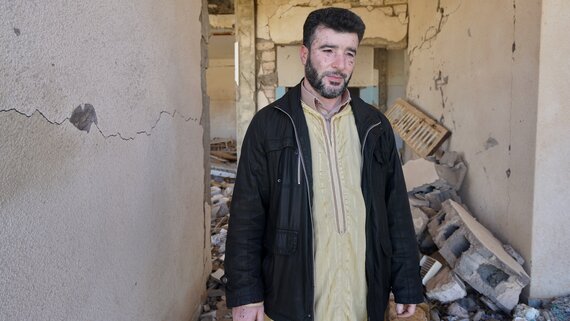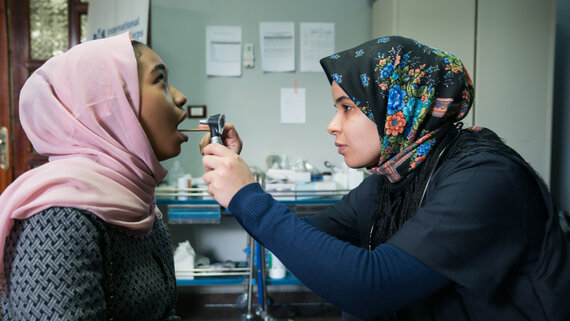Analysis of the context, crisis and needs
Since the ceasefire agreement was signed in October 2020, the overall humanitarian situation has seen some improvement across Libya, highlighted by the continuing trend in the number of internally displaced persons (IDPs) returning to their areas of origin. The number of IDPs decreased nearly 25 per cent to 213,000 people compared to some 278,000 at the start of 2021. This is an encouraging trend, but challenges remain in ensuring that returnees and vulnerable populations have access to essential services, such as health care, safe drinking water and suitable housing. Planned and often forcible evictions targeting IDPs is of critical concern, leading to a heightened risk of secondary displacement and insecurity over housing, land and property rights. Returns continue but the trend is slowing as those still displaced face systemic impediments, including personal security and social cohesion, and require durable solutions.
According to IOM’s Displacement Tracking Matrix, nearly 598,000 migrants are in Libya. The trend of migrants and refugees attempting the dangerous journey to cross the Mediterranean to seek economic opportunities has continued. By the end of September 2021, the Libyan Coast Guard had intercepted and returned almost 26,000 migrants and refugees to Libya. At the same time, the number of migrants and refugees held in detention centres run by the authorities has increased significantly since the beginning of the year and more so in recent months, as authorities mount security operations to round up migrant populations in Tripoli. As of 17 October, over 7,000 migrants and refugees were held in dire conditions in detention centres, without access to due process, compared to some 1,000 detainees in January.

Awenia, Libya
This doctor was appointed as the Director of the Mashasheya hospital in Awenia. Before 2011, over 100 staff served a community that numbered around 15,000 people. This mountainous region saw some of the heaviest fighting during the 2011 revolution. Villages of suspected pro-Gaddafi supporters were attacked and destroyed and still lie in ruins. People now returning live in difficult conditions, as many houses have no electricity or running water and winters are often harsh. The Mashasheya hospital suffered major damage and remained closed until October 2018. The doctor, who had recently returned from Tripoli, offered to re-open part of the damaged facility. Despite the fact there was no electricity or running water, he treated patients with basic injuries.
OCHA/Giles ClarkeLibya continues to struggle with the challenges of the COVID-19 pandemic, straining the already fragile health system. Libya only began its vaccination campaign in April 2021. Vaccination remains slow (5.7 per cent fully vaccinated) and the pandemic will continue to pose risk for the population and operational challenges for the response. With no national budget approved for 2021, the lack of funding hampered programming and impacted health facilities’ ability to remain fully operational.
Vulnerable families are negatively impacted by the rise of the Minimum Expenditure Basket, which increased by 2 per cent by July. Between June and July, a 2.2 per cent raise was noted in the price of the food components. The price of some components decreased, but it remains 13 per cent higher than pre-COVID-19 levels, which, combined with the loss of income and lack of work opportunities, has increased coping mechanisms.
Primary infrastructure requires urgent rehabilitation. Armed groups and criminals increased their attacks on water and sanitation infrastructures, which led to the stoppage of regular water supply in some areas, coupled with deteriorating desalination plants and electricity cuts. This affected approximately 1.6 million people.
Projected situation in 2022 and beyond
An estimated 800,000 people need some form of humanitarian assistance next year, a 36 per cent decrease compared to 2021. Based on the multisectoral severity scale, the highest needs are found in Bani Waleed and Rigdaleen Baladiya in the west region; Ghat and Ubari in the south; and Albayda, Tazirbu, Derna and Jalu in the east. The most vulnerable groups are IDPs, migrants and refugees.

Tripoli, Libya
A doctor performs a medical examination at a migrant health clinic in Tripoli. Lack of funding hampered programming and affected health facilities’ ability to remain fully operational.
OCHA/Giles ClarkeIf the political reconciliation continues, some of the most pressing humanitarian concerns should decrease, especially for non-displaced and returnee populations. Access to services would likely improve as increased revenue, specifically from the oil sector, would allow more investment in public services delivery. If conflict returns, an estimated 1.6 million people could be affected. Preparedness efforts are in place for a rapid response in case needed. The main challenges are the limited presence of operational partners on the ground and safe storage facilities that could allow the pre-positioning of supplies.
Response priorities in 2022
IDPs, returnees, migrants, refugees and non-displaced people are currently affected in Libya and will remain the priority vulnerable groups from January to May 2022. The Humanitarian Response Plan (HRP) will target some 211,000 of the most vulnerable people in the first five months of 2022. Challenges remain for displaced persons with critical protection risks increased by forced evictions and conditions of returns not meeting basic standards; and exposing IDPs, returnees, migrants and refugees to family separation, arbitrary arrest, as well as intimidation by unregulated armed groups.
Libya HRP
The need for a durable solutions approach encompassing physical, material and legal safety remains a priority for the identified groups, many of whom struggle with accessing services or sustainable livelihoods.
The HRP funding requirement from January to May 2022 will be US$75.3 million. The HRP will complement the Libyan Government and private sector efforts to assist the most vulnerable people in need from January to May, while developments on the ground will determine the scale and scope of any future appeal.
Further reading
Source: OCHA
Source: Humanitarian Insight
Source: Financial Tracking Service



